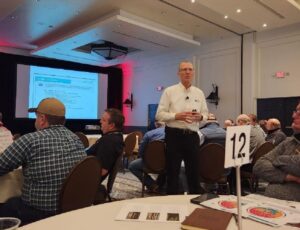Learn how to deal with the Polarity Responder
No, this is not an article about the song by Chubby Checker. The Twist I am referring to is the Polarity Twist.
Flipping through some magazines at my local library, I came across a psychology magazine that ran an article on something called a “Polarity Responder”. Since much of sales and sales management is dealing with the psychology of people, the magazine and specifically this personality type intrigued me. Understanding a Polarity Responder would have helped me tremendously over the years, both as a salesperson and as a sales manager. See if you have a customer or salesperson on your team that fits this category. Learn how to tolerate and possibly benefit from your Polarity Responder versus dreading the moment you interact with them.
Let’s start with a definition or description. First, it’s not a disorder or problem that needs to be fixed. This discussion is about you becoming aware of this personality type, understanding how to identify it and then how to successfully sell to or manage this person.
In simple terms, a Polarity Responder is that person that disagrees with everything you say. And I mean everything. You say the sky is blue and the Polarity Responder immediately disagrees and says the sky is gray. They are driven to interrupt and inform you that you are wrong. Over the years, I supervised and sold to many people who fit this profile, but never realized it was a “thing”. I just thought they either didn’t like me or they just always had to be right. After studying the concept of a Polarity Responder, I realized it wasn’t just me that they reacted to in this way. The Polarity Responder acts this way to most people, especially those that are in leadership positions.
It doesn’t mean that every person that disagrees with you is a Polarity Responder. Here are some examples to help identify the characteristic.
Indications you are dealing with a Polarity Responder:
- Often, they do exactly the opposite of what you want or ask them to do.
- In meetings, they always present reasons for NOTdoing something instead of looking for reasons to do it!
- Frequently, their first response will be to produce an exception to the rule. “Greg, that’s great but it won’t work for the customer that has 3 dogs, 2 cats, and a turtle.” Then I would go to great length to explain how it would work for this unique customer. After which, the Polarity Responder would say, “Yeah, but what if they also have a Chinchilla?” and the game just keeps going.
- They see their response as an opportunity to show how smart they are.
- They tend to be analytical and very intelligent.
- They use “But”, “However” and “On the other hand” often. These terms negate everything you just said. For example, a Polarity Responder may say, “I agree with you, but that won’t work on my farm….” And then they go into details of why your idea or product won’t work for them. Again, one time doesn’t make someone a Polarity Responder. Look for the pattern. You’ll recognize it when it happens.
Understand that this person is motivated to respond this way for several reasons. They want to show you how smart they are. They want recognition for knowing or accomplishing things. They definitely don’t want to be stereotyped or lumped into a category. It can often revolve around a control issue. A Polarity Responder might feel they should be the manager and this is a way for them to exert some form of control.
What to do when selling to a Polarity Responder? Do the Twist
Twist your comments into the negative form. Let’s look at a sales example of a Polarity responder that you have the pleasure of calling on. Instead of telling him all about a feature/benefit of your product, do the Polarity Twist. “You probably don’t need to worry about digestible amino acids with your animals….” Before you even finish that sentence, the Polarity Responder will correct you. “Oh Yes we do get concerned about digestible amino acids.” And then they go on and on about how wrong you are and how important they are to their animals. That’s when you jump in with, “Great! Because our product is based on balancing to – not just the essential amino acids but the digestible levels of essential amino acids.” Since the Polarity Responder just told you how important they are, he really can’t go back on his word without a lot of difficulty. If you are a card player, this is getting them to show you their cards first.
If you feel like this is a little manipulative, it sort of is and sort of is not. In my example, the digestible levels are important. It only makes sense that it’s more important to work with the levels of amino acids that are actually used (digestible). However, if you approach it head on with this customer, they are built to deny your ideas. If one of your competitive advantages is digestible amino acids, then you have to get around this personality characteristic to help him with his feeding program. Otherwise, you will present features and benefits all day long and meet with resistance on every single one.
Other versions of a Polarity Twist:
- “You’re probably not going to like this, but…”
- “This might not work, but we could…”
What to do when managing a Polarity Responder?
- Recognition: This person wants people to know how much they know. As their manager, giving them this recognition can reduce the intensity of their polarity responses and puts them at ease.
- Set Limitations: Talk to them offline if their interruptions are becoming too negative or disruptive. “I know how skilled you are in this area, but we need more open discussion on the topics. When you respond with all the ways it won’t work, many people in the meeting stop giving feedback. I would like for you to hold back on responding so quickly to new ideas…”
- Pre-meeting Meeting: Meet with your Polarity Responder ahead of the main group. Get their feedback before the meeting. Make any appropriate changes based on their feedback. Then you can refer to them in the meeting as helping bring this topic to the team.
- Preemptive Strike: Identify the negative points before they have a chance to respond. “Some of you might not like this new CRM because it’s hard to log into, but here’s why you will like it….”
- Exaggerate their negativity: “You’re right Bob, we should just quit selling the benefits of our products and cut our price in half…” Use this technique sparingly. It’s best used for those people that are just not listening to reason or who are derailing a meeting. It has the potential to really demotivate a person. So, if you use this technique and the person shuts down, you need to do some one-on-one coaching afterward to get through it.
- Assign them the impossible: “Carol, we have been trying to solve this order entry cut off issue for months and I don’t have any idea where to go from here. You want to take a shot at it?” Important note: If Carol does take the challenge and she does solve the problem, you need to publicly recognize her many times for her contributions.
At first glance, a Polarity Responder can seem like a problem employee. However, after you identify the characteristics and understand how to interact with them, you realize how much of an asset they are to your team. They will actually help you find holes in your programs that you didn’t see.
The customer Polarity Responder is a litmus test for your products. This person will push you on every feature and benefit. You become smarter on your products by the challenges the Polarity Responder throws at you. Learning to use their response as a resource not only helps you sell or manage but helps the rest of the team get better.
Testing yourself on your Polarity Response:
“You probably don’t agree with me on this article, but I think it’s a great way to understand one of the more difficult people in our lives.”
Did you stop mid-sentence and say “Yes” or “No”?
Want to learn more about the critical skills of being an Ag Sales Professional?
Download the Webinars on:
Closing Skills
Price Resistance
Cold Calling
High-Value Questions
- Four of the most critical skill areas to grow your territory and dominating your market
- If you enjoy and learn from my blog posts, you will love these webinars. They dig deeper into the four areas.
- Practical skills you can take out and apply immediately to your sales calls
Make your next meeting memorable by bringing in a speaker who’s been there. Contact me to find out how Greg@GregMartinelli.net (608) 751-6971
For more Ag Sales Training, Ag Sales Coaching and Leading Ag Sales Teams, go to http://www.GregMartinelli.net/



